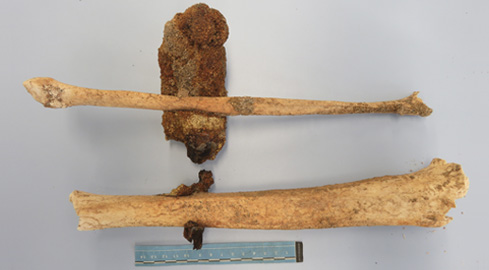UAB researchers shed light on the remains of Born's medieval Islamic cemetery
Genetic and anthropologic studies of the remains from the Islamic necropolis dating back to the Middle Ages and located in the Born district of Barcelona, conducted by researchers in Biological Anthropology at the UAB and researchers from the History Museum of Barcelona, have led to the identification of up to 18 individuals, one of whom had been buried with shackles. All 18 had different mitochondrial DNA lineages – mainly from Europe, but also from Africa – pointing to a high degree of diversity which could be related to a considerable number of Muslim inhabitants within the city. The individuals would have formed part of the lowest rungs of society.

Specialists in the fields of archaeology, biology, restoration, and history announced the most recent results of a study on the remains found at a medieval Islamic cemetery in the Born district of Barcelona at a conference held on 14 December 2021 at the El Born Cultural and Memorial Centre.
The study, led by the History Museum of Barcelona (MUHBA), also included the involvement of a research team from the UAB Department of Animal Biology, Plant Biology and Ecology (BABVE): the genetic analyses were conducted by Biological Anthropology Professor Assumpció Malgosa, and by lecturer Cristina Santos, alongside PhD students Diana Vinueza and Daniel Ruiz.
The anthropological study was led from MUHBA by Núria Armentano, lecturer at BABVE, with the collaboration of Ignasi Galtés, researcher at the Institute of Forensic Science and Legal Medicine of Catalonia and lecturer of the UAB Legal and Forensic Medicine Unit, as well as Mònica Cos, from the Institute of Diagnostic Imaging of the University Hospital of Bellvitge, who focused on the tomographic and radiological study of the skeletal remains.
During their speeches at the conference, the researchers explained that their analyses had allowed them to identify the remains of at least 18 individuals, mainly male adults (only three women and two children were identified), who were all buried in a lateral decubitus position, following the Muslim burial tradition. Among these individuals, there is one who stands out, number 15, whose only remains were his lower extremities, with metal rings fastened to the ankles. These rings were identified as medieval shackles, lightweight and simple in design.
The individuals were discovered to be suffering from generalised periodontitis, as well as having bone porosity, which is commonly related to nutritional deficiencies. Moreover, they presented a restructuring of the skeleton affecting the upper parts of their arms, where muscles attach to the bones, suggesting that these individuals had spent a long time carrying out very demanding physical activities which required the use of their arms. This information, alongside the shackles found on individual #15 and the lacerations on the tibiae of some of the skeletons, has led researchers to think that they belonged to the lowest rungs of society, and that they were slaves or domestic servants. Nevertheless, it is also possible that individual #15 had been a prisoner.
Not only that, but the mitochondrial DNA (which is only inherited from the mother) analyses conducted in the ancient DNA laboratory of the UAB’s Biological Anthropology Unit revealed up to 18 different lineages, stemming from Europe (in 70% of the remains) and from Africa (in the remaining 30%), pointing to a large diversity in the origins of the inhabitants. The lack of kinship among the individuals could be an indicative of a considerable number of Muslims living in Barcelona at that time.
The medieval Islamic necropolis located in the Born district is the only one to have been found in Barcelona dating back to the Middle Ages. It was discovered during an archaeological dig which took place in 1991. Containing remains from the 11th and 12th centuries (High Middle Ages), the cemetery was located outside the city walls (a tradition also seen in Roman times), on the coastal road leading to one of the gates of the Roman wall, located at what is now the Plaça de l’Àngel. The fact that the Muslim community would have had its own necropolis is a sign of the important size of this community, whose members lived dispersed throughout the city, as recorded in historical documents.